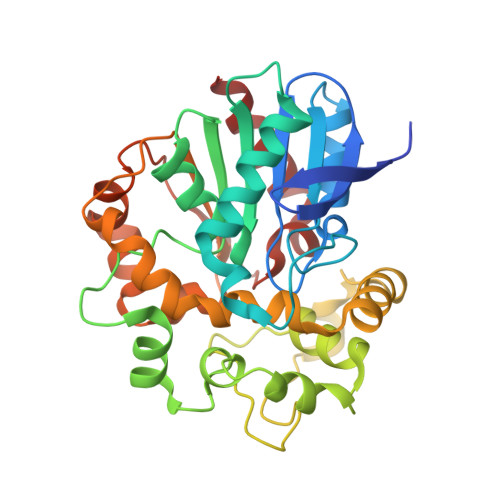Expanding the Catalytic Triad in Epoxide Hydrolases and Related Enzymes.
Amrein, B.A., Bauer, P., Duarte, F., Janfalk Carlsson, A., Naworyta, A., Mowbray, S.L., Widersten, M., Kamerlin, S.C.(2015) ACS Catal 5: 5702-5713
- PubMed: 26527505
- DOI: https://doi.org/10.1021/acscatal.5b01639
- Primary Citation of Related Structures:
4Y9S - PubMed Abstract:
Potato epoxide hydrolase 1 exhibits rich enantio- and regioselectivity in the hydrolysis of a broad range of substrates. The enzyme can be engineered to increase the yield of optically pure products as a result of changes in both enantio- and regioselectivity. It is thus highly attractive in biocatalysis, particularly for the generation of enantiopure fine chemicals and pharmaceuticals. The present work aims to establish the principles underlying the activity and selectivity of the enzyme through a combined computational, structural, and kinetic study using the substrate trans -stilbene oxide as a model system. Extensive empirical valence bond simulations have been performed on the wild-type enzyme together with several experimentally characterized mutants. We are able to computationally reproduce the differences between the activities of different stereoisomers of the substrate and the effects of mutations of several active-site residues. In addition, our results indicate the involvement of a previously neglected residue, H104, which is electrostatically linked to the general base H300. We find that this residue, which is highly conserved in epoxide hydrolases and related hydrolytic enzymes, needs to be in its protonated form in order to provide charge balance in an otherwise negatively charged active site. Our data show that unless the active-site charge balance is correctly treated in simulations, it is not possible to generate a physically meaningful model for the enzyme that can accurately reproduce activity and selectivity trends. We also expand our understanding of other catalytic residues, demonstrating in particular the role of a noncanonical residue, E35, as a "backup base" in the absence of H300. Our results provide a detailed view of the main factors driving catalysis and regioselectivity in this enzyme and identify targets for subsequent enzyme design efforts.
Organizational Affiliation:
Science for Life Laboratory, Department of Cell and Molecular Biology, Uppsala University , BMC Box 596, SE-751 24 Uppsala, Sweden.














